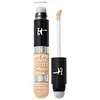What's inside
What's inside
 Key Ingredients
Key Ingredients

 Benefits
Benefits

No benefits
 Concerns
Concerns

 Ingredients Side-by-side
Ingredients Side-by-side

Water
Skin ConditioningCoco-Caprylate/Caprate
EmollientHydrogenated Polyisobutene
EmollientGlycerin
HumectantPropanediol
SolventPropylene Glycol
HumectantSorbitan Isostearate
EmulsifyingPolyglyceryl-6 Polyricinoleate
EmulsifyingNiacinamide
SmoothingSynthetic Fluorphlogopite
Hydroxyethylpiperazine Ethane Sulfonic Acid
BufferingPhenoxyethanol
PreservativeMagnesium Sulfate
Disodium Stearoyl Glutamate
CleansingParaffin
PerfumingHydroxyacetophenone
AntioxidantDisteardimonium Hectorite
StabilisingCera Microcristallina
Emulsion StabilisingCaprylyl Glycol
EmollientSilica Silylate
EmollientSilica
AbrasiveSynthetic Wax
AbrasiveCaffeine
Skin ConditioningCentella Asiatica Extract
CleansingTrisodium Ethylenediamine Disuccinate
Aluminum Hydroxide
EmollientTocopherol
AntioxidantAdenosine
Skin ConditioningSodium Hyaluronate
HumectantHydrated Silica
AbrasiveHelianthus Annuus Seed Oil
EmollientMethicone
EmollientCI 77891
Cosmetic ColorantCI 77491
Cosmetic ColorantCI 77492
Cosmetic ColorantCI 77499
Cosmetic ColorantCI 77007
Cosmetic ColorantCI 15985
Cosmetic ColorantCI 42090
Cosmetic ColorantCI 45410
Cosmetic ColorantCI 15850
Cosmetic ColorantWater, Coco-Caprylate/Caprate, Hydrogenated Polyisobutene, Glycerin, Propanediol, Propylene Glycol, Sorbitan Isostearate, Polyglyceryl-6 Polyricinoleate, Niacinamide, Synthetic Fluorphlogopite, Hydroxyethylpiperazine Ethane Sulfonic Acid, Phenoxyethanol, Magnesium Sulfate, Disodium Stearoyl Glutamate, Paraffin, Hydroxyacetophenone, Disteardimonium Hectorite, Cera Microcristallina, Caprylyl Glycol, Silica Silylate, Silica, Synthetic Wax, Caffeine, Centella Asiatica Extract, Trisodium Ethylenediamine Disuccinate, Aluminum Hydroxide, Tocopherol, Adenosine, Sodium Hyaluronate, Hydrated Silica, Helianthus Annuus Seed Oil, Methicone, CI 77891, CI 77491, CI 77492, CI 77499, CI 77007, CI 15985, CI 42090, CI 45410, CI 15850
Mica
Cosmetic ColorantTalc
AbrasiveCalcium Sodium Borosilicate
Phenyl Trimethicone
Skin ConditioningEthylhexyl Palmitate
EmollientIsononyl Isononanoate
EmollientTridecyl Trimellitate
EmollientMagnesium Myristate
Methyl Methacrylate Crosspolymer
Nylon-12
Magnesium Stearate
Cosmetic ColorantSilica
AbrasiveBoron Nitride
AbsorbentPolyethylene
AbrasiveTocopheryl Acetate
AntioxidantSynthetic Fluorphlogopite
Isostearyl Isostearate
EmollientTin Oxide
AbrasiveCaprylyl Glycol
EmollientEthylhexylglycerin
Skin ConditioningPhenoxyethanol
PreservativeCI 77891
Cosmetic ColorantIron Oxides
CI 19140
Cosmetic ColorantCI 77007
Cosmetic ColorantCI 77742
Cosmetic ColorantCI 15985
Cosmetic ColorantCI 15850
Cosmetic ColorantCI 16035
Cosmetic ColorantCI 45410
Cosmetic ColorantCI 17200
Cosmetic ColorantCI 77163
Cosmetic ColorantCI 42090
Cosmetic ColorantCI 77288
Cosmetic ColorantMica, Talc, Calcium Sodium Borosilicate, Phenyl Trimethicone, Ethylhexyl Palmitate, Isononyl Isononanoate, Tridecyl Trimellitate, Magnesium Myristate, Methyl Methacrylate Crosspolymer, Nylon-12, Magnesium Stearate, Silica, Boron Nitride, Polyethylene, Tocopheryl Acetate, Synthetic Fluorphlogopite, Isostearyl Isostearate, Tin Oxide, Caprylyl Glycol, Ethylhexylglycerin, Phenoxyethanol, CI 77891, Iron Oxides, CI 19140, CI 77007, CI 77742, CI 15985, CI 15850, CI 16035, CI 45410, CI 17200, CI 77163, CI 42090, CI 77288
Ingredients Explained
These ingredients are found in both products.
Ingredients higher up in an ingredient list are typically present in a larger amount.
Caprylyl Glycol is a humectant and emollient, meaning it attracts and preserves moisture.
It is a common ingredient in many products, especially those designed to hydrate skin. The primary benefits are retaining moisture, skin softening, and promoting a healthy skin barrier.
Though Caprylyl Glycol is an alcohol derived from fatty acids, it is not the kind that can dry out skin.
This ingredient is also used as a preservative to extend the life of products. It has slight antimicrobial properties.
Learn more about Caprylyl GlycolCi 15850 is the pigment color red. It is an azo dye and created synthetically.
Azo dyes need to be thoroughly purified before use. This allows them to be more stable and longer-lasting.
This ingredient is common in foundations, lipsticks, and blushes. This color is described as brown/orangey red.
It has many secondary names such as Red 6 and Red 7. According to a manufacturer, Red 6 usually contains aluminum.
Learn more about CI 15850Ci 15985 is a dye made from petroleum. It is synthetically created and approved by the FDA for use in foods and cosmetics.
The color of this dye is orange/yellow.
This ingredient can be found in makeup, sun care, and skincare.
Learn more about CI 15985Ci 42090 is a synthetic dye created from petroleum. It is used to give a bright blue color to cosmetics, medicine, and food.
CI 45410 is a synthetic red-pigment and dye.
It often goes by both Red 28 or Red 27; manufacturers label both ingredients as CI 45410.
This dye is commonly found in makeup because it imparts a vivid color. Some types of this dye change color based on pH level and interaction with moisture:
Your skin has a natural pH of around 4.5 - 5.5.
According to the FDA, CI 45410 is not permitted for use in eye products.
Red 27 is a flourescein dye and commonly used as a fluorescent tracer in medicine.
Learn more about CI 45410This pigment is called Ultramarine blue lazurite. It gives a saturated blue color, but can be used to create other colors as well.
According to the manufacturer, it is usually made from kaolin, sodium sulfate, sodium carbonate, sulfur, and charcoal.
Ci 77891 is a white pigment from Titanium dioxide. It is naturally found in minerals such as rutile and ilmenite.
It's main function is to add a white color to cosmetics. It can also be mixed with other colors to create different shades.
Ci 77891 is commonly found in sunscreens due to its ability to block UV rays.
Learn more about CI 77891Phenoxyethanol is a preservative that has germicide, antimicrobial, and aromatic properties. Studies show that phenoxyethanol can prevent microbial growth. By itself, it has a scent that is similar to that of a rose.
It's often used in formulations along with Caprylyl Glycol to preserve the shelf life of products.
Silica, also known as silicon dioxide, is a naturally occurring mineral. It is used as a fine, spherical, and porous powder in cosmetics.
Though it has exfoliant properties, the function of silica varies depending on the product.
The unique structure of silica enhances the spreadability and adds smoothness, making it a great texture enhancer.
It is also used as an active carrier, emulsifier, and mattifier due to its ability to absorb excess oil.
In some products, tiny microneedles called spicules are made from silica or hydrolyzed sponge. When you rub them in, they lightly polish away dead skin layers and enhance the penetration of active ingredients.
Learn more about SilicaSynthetic Fluorphlogopite is the synthethic version of mica. It consists of fluorine, aluminum and silicate.
Synthetic Fluorphlogopite is used to add volume to products.
It is considered non-irritating on the skin.
Learn more about Synthetic Fluorphlogopite